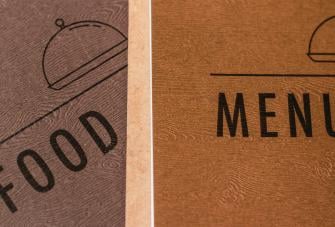How to Create a Takeout and Delivery Menu
Recently, many restaurants have been forced to provide delivery and curbside takeout because of the Covid-19 pandemic. However, despite this ongoing situation, online ordering has been growing in popularity for many years and is expected to grow to a $365 billion industry by 2030.
To ensure future success, you should do everything possible to cater to this demand. Building a website and integrating with food delivery apps is a good start, but you also want to make sure you have a fully optimised takeout and delivery menu.
Too many restaurants have poor takeout menus
Countless small businesses across the country have started offering online ordering, but they are not seeing the sales they expected. Why are some restaurants flourishing while others are struggling to keep the lights on?
Not having a digital menu
In a world where everything is accessible at the touch of a button, why are some establishments still using outdated menus? It is not uncommon to visit a restaurant’s website and see a link to the menu that directs you to a PDF. If you are doing this, you are losing sales. No one wants to download a file and zoom in and out to find a meal.
Even worse, some restaurants use images of their menu. Not only does this speak to the quality of your service, but it also makes the menu inaccessible for those with disabilities who use special software to read text aloud.
Relying on food delivery apps
There is nothing wrong with selling on Uber Eats and other apps, but these should not be your main source of traffic. Apps charge fees that will eat away at your profit margins, and they host all of your competitors in one place. It is too easy for a customer to read over your menu and then back out and go with another business.
Having too large of a menu
People who order online or over the phone want a simple, fast process. When a menu is long, has many pages, and is full of similar meals, people get confused and discouraged. While you want to have variety, offering too much can be overwhelming.
Creating your takeout and delivery menu
Keep it concise
Your menu should be short and sweet. Customers should quickly see what you offer, how much it costs, and how to order. Simplifying your menu helps convert prospective buyers into cash-paying customers.
First, use your restaurant point of sale to analyze your best-selling meals. These are your staple products that people will want. Next, add options for starters, main dishes, sides, desserts, and drinks. Try to limit these to only a handful per category.
Of course, nothing is stopping you from offering all your other options for takeout and delivery. Feel free to include a note at the bottom of the menu that instructs customers to call to make special requests.
Choose easily packaged items
Some meals might taste good, but they aren’t the best for traveling. Items like soups and drinks can spill and leak. Likewise, dishes with tons of grease can soak into their containers, creating a soggy mess.
For starters, focus on items that can be easily wrapped up, such as sandwiches, pastries, and french fries. Likewise, try to swap out heavy dinner side dishes with more manageable products. For example, instead of offering baked beans that can spill, you can provide mashed potatoes or steamed vegetables.
If you offer heavier items, like pasta and roasts, be sure to use robust packaging. You do not want to sacrifice your reputation by using sub-par containers that leak and fall apart.
Put it on a mobile-friendly website
A digital menu is a must in 2021. Customers should be able to see all your options from any device, especially since more people are browsing the web from phones than computers.
If your menu and restaurant website are not mobile-friendly, users will have difficulty reading it and will go elsewhere. Luckily, platforms like BigCommerce make it easy to build a completely responsive website that works on any device.
All images, text, links, videos, and more should automatically resize depending on the size of the screen. This ensures a positive experience and fast load times. Most importantly, being mobile-friendly is vital for search engine optimisation and digital marketing.
Keep it up to date
How often do you change your menu? If you offer seasonal items or have made adjustments, you need to quickly update your menu. Otherwise, customers will be unhappy that your menu had incorrect information. If this happens enough, you will receive several negative restaurant reviews warning others of the misinformation.
For most people, their menu will be a simple webpage on their site. Updating these is as easy as changing your Facebook status. However, it does take a little effort to login to your website and take the time to make the changes.
If you use an ordering platform that is synced to your management software, then you don’t have to worry about anything. If you update the menu on your POS, it will automatically change on your online service.
Use high-quality images and descriptions
Our brains love imagery, which is why commercials for food use slow-motion and incredible detail to catch our attention. Your takeout and delivery menu should do the same.
With images, you can steer customers to certain items and show them exactly what they’re getting. Also, images can make us hungry, leading to impulse buying and larger order sizes.
Likewise, you should provide a brief description of each product so customers are not confused or surprised. Explain what the offer includes, portion size, and any food allergens.
Include specials and combinations
Some people are in a rush when ordering. They just want their favourite foods and do not have time to pick out sides and calculate prices. You can cater to this crowd by adding combinations and weekly specials.
Dedicate a spot on your menu to feature a handful of offers. These can range from simple platters of a meal, side, and drink to a huge sample of various appetisers and desserts. In any event, clearly explain what it includes and the price. By discounting these offers by a small amount compared to ordering all components individually, you can increase your restaurant’s average order size.
Clearly state delivery fees
Customers know all too well that ordering takeout and delivery comes with additional costs. However, these fees should not be a shock to them. Nothing is worse than adding all your favorite items to your basket and then seeing a huge surcharge for delivery.
Either at the top or bottom of your menu, list all applicable fees. Whether you use a percentage or flat rate, make sure it is clear as day to prevent any negative feedback.
Integrate it with your point of sale
Most importantly, you want to reduce expenses as much as possible. Using a third-party app for online ordering is useful, but it leaves you dependent on a service that could end tomorrow. These apps can also charge high fees that force you to raise meal prices.
If you use a modern point of sale, look into online ordering integrations that do not dramatically cut into your profits. For Epos Now customers, turn to Epos Now Order & Pay. This online platform requires no downloads and can be accessed from any device.
Customers can order, pay, and track their meal in real-time via Epos Now Order & Pay. The service synchronises with your POS, so any changes you make will be reflected on the menu. Best of all, you do not have to consolidate sales from one platform to the other. All transactions are logged directly in your Back Office.
Learn more about Epos Now POS systems and online ordering functionality - call today.




